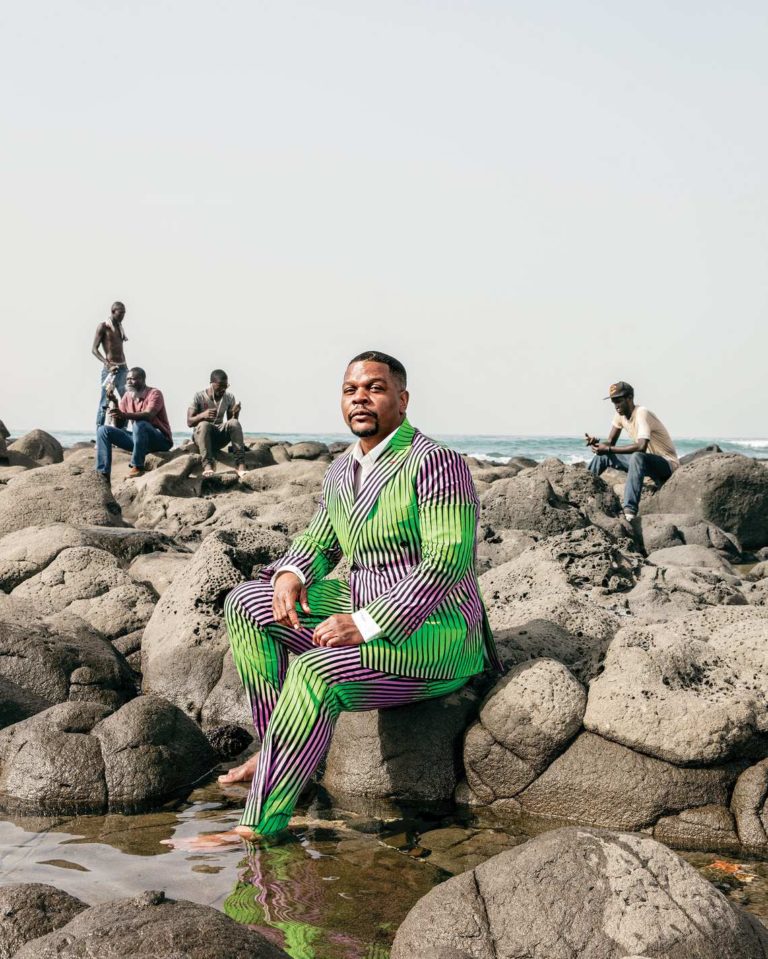Down a nondescript dirt road in the Yoff Virage village in Dakar, beyond a steel-and-wood gate and perched atop an ocher cliff overlooking Yoff Bay, is Black Rock Senegal. It’s the new home, studio space, and artist-in-residency program imagined and brought to life by New York–based painter Kehinde Wiley.
On a balmy day in February, Wiley is standing just outside the towering, 20-foot-tall, double front doors made of Amazakoue wood sourced from Cameroon. Construction workers and staff are moving in every direction, sorting the final details. Wiley closely follows, marking off a checklist that seems to exist only in his head. “People are flying in from around the world,” he says of the launch party he will host in late May, with the first residents arriving shortly thereafter.
Artist residencies have historically been considered ivory-tower enterprises held in long-inherited properties or estates, their hallowed halls guarded by mostly white, mostly male cultural gatekeepers. Black Rock Senegal is one of a slew of new residencies and creative centers now being spearheaded by African-Americans, who are making sure that access, above all, is the point.
Three multidisciplinary artists at a time will be invited to Black Rock Senegal to take part in one-to-three-month sessions. They will be provided with tutoring in English, French, and Wolof. Wiley’s staff will assist in setting up studio visits with local and visiting artists and curators — including those in residence at the nearby Raw Material Company: Center for Art, Knowledge, and Society, which promotes artistic and intellectual creativity in Africa — as well as organizing trips to Gorée Island (from the 15th to the 19th century, the largest slave-trading center on the African coast) and the newly opened Musée des Civilisations Noires.
LEFT: The Front Entrance. The double front doors, which were designed by Vintage NM Design. RIGHT: The Pool and Back Patio. All suites and common areas have views of the infinity pool and Yoff Bay, as well as patios or terraces.
LEFT: Dakar-based artist Omar Victor Diop lounges in front of Fridas from his “Remixing Hollywood” series (2013). RIGHT: The Kitchen. A Black Rock staff member in one of two kitchens, wearing a uniform designed by Sarah Diouf of Tongoro Studio.
Wiley and I have known each other for some time. We met in 2001, when he was invited by a mutual friend to a gathering at my home when he was in the middle of a New York residency at the Studio Museum in Harlem. A direct inspiration for Black Rock, the program was started in 1968 for emerging artists of African and Latino heritage and has helped launch the careers of William Cordova, Njideka Akunyili Crosby, and Leslie Hewitt, among others.
“I’d just graduated from Yale, I didn’t have any money, and I’d sometimes sleep in my studio,” says Wiley. “There was that feeling of destabilization and of fear, that sense of adventure, of not knowing what will come of it. I hope those who come here will feel all that.” Though Wiley has a demanding travel schedule, he plans to be hands-on and present at Black Rock. “For most of these artists, this will be their first time in Dakar,” he says, “so having only three artists at a time will allow for a more immediate experience.”
Designed by Senegalese architect Abib Djenne, the compound is composed of two slate-gray buildings separated by a tropical garden filled with colossal coconut palms, elephant ears, and Petra crotons, along with a stone-wall fountain that trickles down into a koi pond. “Whenever I’d ask around, Djenne’s name kept popping up,” Wiley says. “I wanted someone who would consider and highlight the natural surroundings: the light, the water, and of course the black volcanic rocks that line the shore.”
“I wanted to highlight the NATURAL surroundings... the black VOLCANIC ROCKS that line the shore.”

Kehinde Wiley sits on the rocks that line the coast of The Dakar Shoreline by Black Rock Senegal.
“I wanted to highlight the NATURAL surroundings... the black VOLCANIC ROCKS that line the shore.”

Kehinde Wiley sits on the rocks that line the coast of The Dakar Shoreline by Black Rock Senegal.
The main house, with its wall of windows, covers almost 4,000 square feet and contains Wiley’s personal studio. Though residents will have access to its gym, infinity pool, steam room, and sauna during the day, they will be installed in a 2,000-square-foot building next door in three-story townhouses. The airy, art-filled interiors are a collaboration between Wiley, Fatiya Djenne (the architect’s daughter), and Dakar- and Paris-based textile designer Aissa Dione.
A lot has changed for Wiley since he and I stood on this rock-and-litter-filled plot over five years ago, when the project was conceived and we were in Dakar celebrating his birthday. “Not even the thought of doing the official portrait of the first black president existed back then,” says Wiley. (He, of course, was commissioned to paint President Obama back in 2017.) As we move into one of the grand living-room areas, Wiley takes a seat in what has become his favorite comfortable chair and takes a sip of Macallan 12. “I was just living, taking what I knew, believed in at that moment, and wanting to move things forward. And here we are.”
